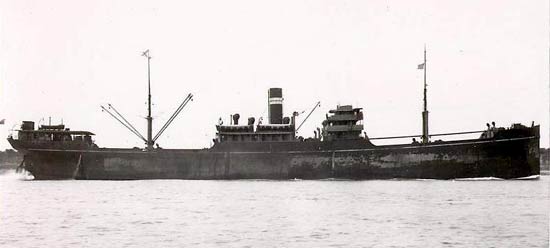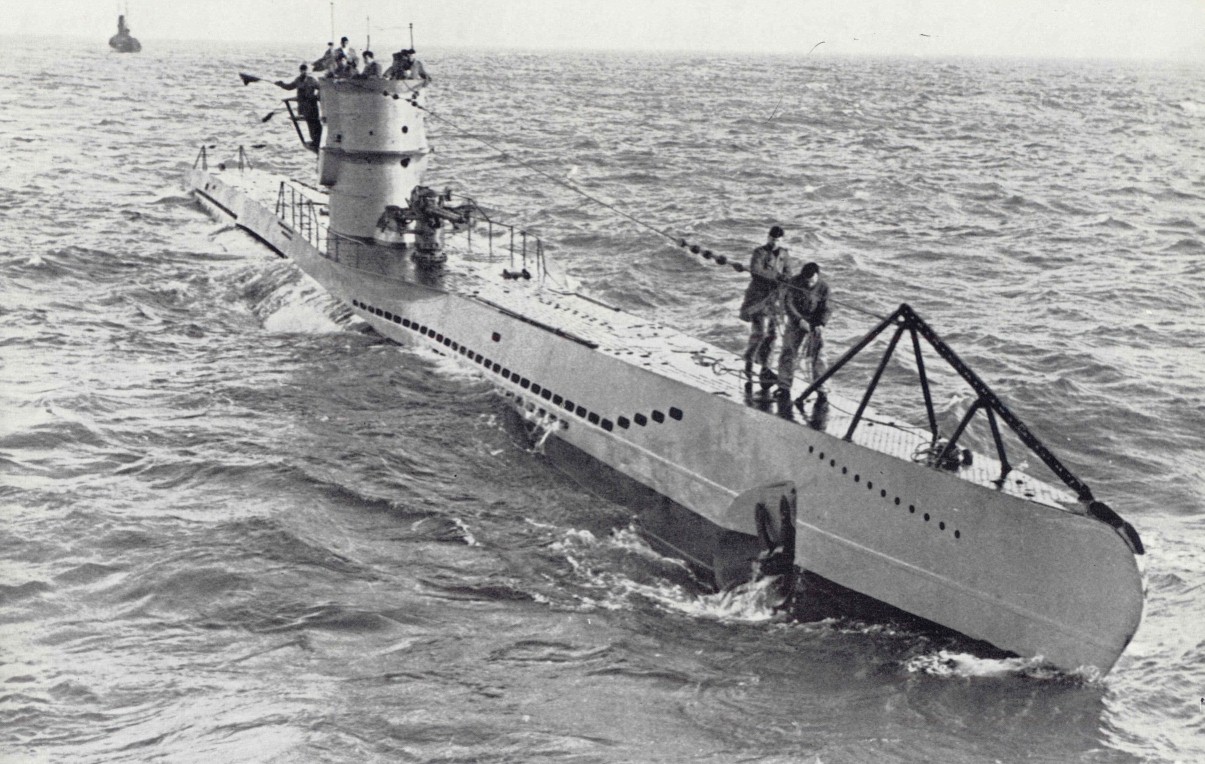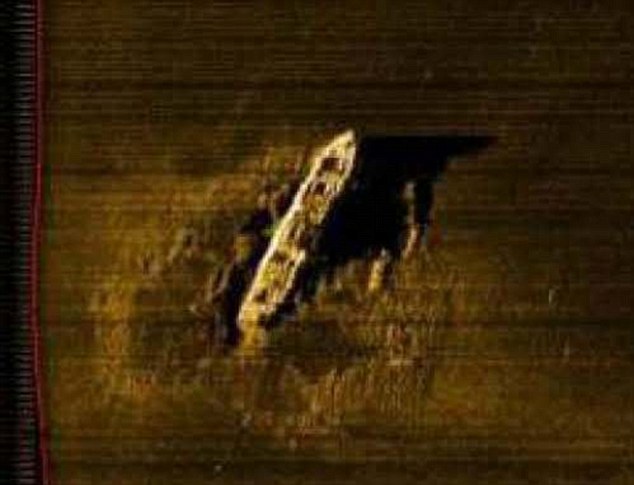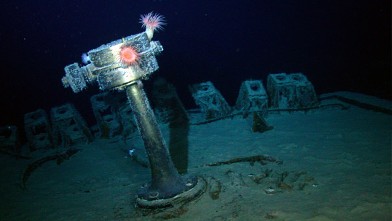
Uboat.net reports this vessel as
follows:
Name: Gairsoppa
Type: Steam merchant
Tonnage5,237 tons
Completed: 1919 - Palmers Shipbuilding & Iron Co Ltd,
Hebburn-on-Tyne
Owner: British India Steam Navigation Co Ltd, London
Homeport: Glasgow
Date of attack: 17 Feb 1941~
Nationality: British
Fate: Sunk by
U-101
(Ernst
Mengersen)
Position: 50.00N, 14.00W -
Grid BE 3437
Complement: 86 (85 dead and 1 survivor).
Convoy
SL-64 (detached)
Route Calcutta - Freetown
(30 Jan) - Galway, Ireland - London
Cargo 2600 tons of pig iron, 1765 tons of tea, 2369 tons
of general cargo and 200 tons of silver ingots and coins (£600,000)
History: Laid down as
War Roebuck
for The Shipping Controller, completed in October 1919
as Gairsoppa
for British India Steam Navigation Co Ltd, London.

U-101
|
At 0008
hours on 17th February 1941, the Gairsoppa
(Master Gerald Hyland) was hit on the starboard side just behind the bridge in
No: 2 hold by a torpedo from
U-101 about 300 miles
southwest of Galway Bay, Ireland. The ship had been in convoy
SL-64 which was slowed
down by bad weather and running low on coal, she was detached alone to Galway on
15th February. At 1800 hours on 16th February, the U-boat spotted the ship but
had difficulties hitting the target due to heavy seas and missed with a spread
of two torpedoes at 2328 hours and then by one G7e torpedo at 2332 hours. The
S.S. Gairsoppa caught fire
and settled slowly by the bow after being hit in the third attack, but Mengersen
decided to give up further attacks when a coup de grāce missed at 0020 hours,
assuming correctly that the burning freighter will sink anyway in the heavy
seas. The survivors managed to abandon ship in three lifeboats before she sank
within 20 minutes. However, two of the boats were never seen again and its
occupants presumably perished in the cold and bad weather. The boat which was in
charge of by the second officer set sail with eight Europeans and 23 Lascars
aboard, but after seven days most had died of exposure and only four Europeans
and two Lascars were still alive when the boat reached land on 1st March. Sadly,
it capsized in the swell and surf of Caerthillian Cove on The Lizard, Cornwall
and all occupants drowned except the second officer, who was rescued unconscious
by a coastguard.
The bodies of
two Europeans and the two unidentified Lascars were recovered and buried in the
Landewednack Churchyard. The master, 82 crew members and two gunners were lost.
The Second officer was Richard Ayres. His story of rescue is almost miraculous
as he began to fade away in the surf pounding the Cornish beach. He began to
hear children's voices drifting to him on the wind. They were calling to him.
Barely conscious, he made one last effort and found that a rope was thrown
alongside him. He managed to wrap it around his body and he was dragged
unconscious onto the beach. But alive and on British soil.
70 years
later, now 2011, Odyssey Marine Exploration Inc had found the wreck and will
salvage the silver. Value then wass possibly £155m, 80% will go to the Company
and 20% to the British Government. The Gairsoppa lies 3 miles down, and approx
300 miles southwest of Ireland. In the spring of 2012 they intend to begin
salvage.
2013: tv programme
'Treasure Quest' showed maritime treasure ship that found Gairsopa, recovered a
couple of ingots of silver, total estimated value of cargo £200 million now.
The Crew
List can be found here:
http://uboat.net/allies/merchants/crews/ship765.html
|
|

|
 |
|
The Gairsoppa
was just one of 38 ships sunk during the month of February 1941. The ship was
bearing 7000 tonnes of cargo which included the silver, tea and iron. She was
forced to burn more and more fuel in order to maintain headway in the heavy
seas. Her skipper, Captain Gerald Hyland, did not think his fuel would last
until Liverpool, so he asked for, and obtained, permission to detach from the
convoy and make way to Galway to refuel. On February 14th he detached from the
convoy. She had initially left Calcutta in December 1940 steaming along the
African coast until she reached Freetown, Sierra Leone. It was here she joined
Convoy SL64 for Liverpool.
U Boat Machine
Gunned The Decks
On February
16th 1941 a Focke Wolfe Condor spotted the ship and began circling, relaying
information to U Boats about a lone ship. The U101 changed course and began to
close on the Gairsoppa's position. At 2330 hrs the third torpedo of 3 fired, hit
the ship and in 20 minutes she went down. The Foremast snapped, taking with it
the radio aerial. Then, as the survivors began the ordeal of abandoning ship,
machine gun bullets ripped
through the deck, the U Boat had surfaced and was
firing along the decks. The
bullets cut through the ropes of one of the lifeboats, sending it crashing into
the sea. Dozens of men leapt into the sea and made their way towards the
lifeboat, one of these was Richard Ayres.
Lascars went
Insane
Of the other
lifeboats there was no sign, and the Gairsoppa had gone down, 20 minutes after
the torpedo had hit. The lone lifeboat had 31 men on board, 8 Europeans
and 23 Indian sailors, known collectively as Lascars. They all immediately began
suffering terrbily from the cold. Ayres, took command, and began sailing east.
(I wonder if the better
option would have been sailing north east, they would have possibly landed on
Irish soil before they had nearly all died - mk.)
All they had was condensed milk and hard biscuits, so hard in fact that it could
hardly be swallowed. Each water ration was half pint day, half pint nightly, but
the Lascars began drinking sea water which made them insane and they began
fighting each other. On day 8, the water ran out. Soon after men began
dying. None of the remaining survivors knew their whereabouts nor chances
or rescue.
|
| According to
Ayres, the men became delirious, a couple of rain showers gave brief respite
from their burning throats. Ayres sailed the little boat through towering waves
and gale force winds. Only he, a radio officer 18 years old Robert Hampshire and
an 20 year old gunner, Norman Thomas, had the strength to hold the rudder. 13
days after the Gairsoppa had gone down, the men thought they saw land, but it
could have been a cloud! Then someone croaked 'Land!'. They had spotted the
Lizard Lighthouse on the southernmost tip of Cornwall. Ayres set course
for a rocky cove by the surf was too much and the boar capsized. Another
wave righted the boat and the three managed to scramble on board only for
another wave to turn the boat over again. Within sight of the shore, only Ayres
survived this turn of events. Thomas actually made it to the rocks but a wave
took him away, drowning him just yards from safety. |
Three young
evacuees from Tottenham, London had been walking along the cliffs when they
spotted the boat. Betty Driver, Olive Martin and her sister. One ran for help to
the farm, the other two raced down to the beach and began shouting to the men. a
Coastguard, Brian Richards, arrived and threw Ayres a rope. The bodies of two
Lascars, Hampshire and Thomas were all buried in a nearby cemetery. Ayres had
landed at Caerthillian Cove, only a few miles from his home. He was later
awarded an MBE as well as a War Medal for bravery at sea. Ayres returned to sea
but spoke little about his ordeal. Something quite common amongst many of our
seamen and Forces in WW2. He died in 1992.
|
 |
|
Footnote: The fate of
the U boat 101: Stricken at Neustadt on 21 Oct, 1943.
Scuttled
there on 3 May, 1945. Wreck broken up.
http://www.uboat.net/boats/u101.htm |
| |
|
|
|
![]()